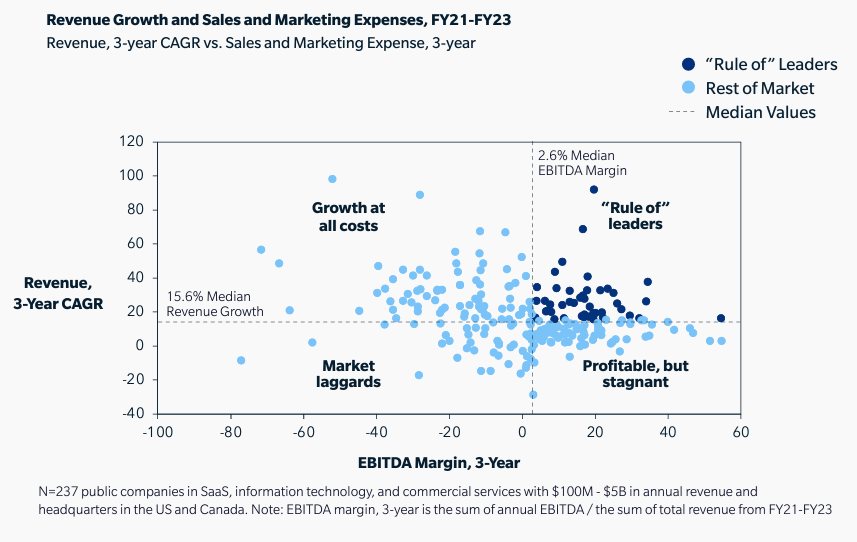How Your Growth is Closely Tied to Commercial Efficiency


At an event in Washington, D.C. earlier this month, we talked about the “profitability paradox” to describe what businesses are facing in today’s market environment. In simpler times, it was common sense that businesses that invested more in growth could expect to see greater returns.
But with issues like inflation and higher wages affecting the market today, companies find themselves needing to spend significantly more on sales and marketing today compared to three years ago to generate less revenue than before. This erosion in commercial efficiency is causing profitable growth to become more and more elusive to many B2B companies.
In our latest research, we surveyed go-to-market (GTM) leaders from a variety of companies to understand today’s profitability paradox and examine what market leaders do differently to successfully achieve greater commercial efficiency.
The state of today's business environment
From a business standpoint, we’re seeing three alarming trends in the market today:
1. Profitable growth is getting more elusive
With the slowing demand observed across most sectors (especially in SaaS), the “Rule of 40” no longer seems realistically achievable for many companies, with the combined numbers of EBITDA margins and revenue growth falling by a staggering 45% from 2021 to 2023. Thanks to rising inflation and reduced demand, the percentage of companies reporting profitable growth has fallen from 64.1% in 2022 to 51.8% in 2023. GTM leaders acknowledge that this downward trend cannot continue, but also recognize that the underlying causes such as higher interest rates and more expensive talent are likely here to stay—thus making it even more important to adapt.
2. The gradual erosion of commercial efficiency
Companies across the board are feeling the pinch of slower growth combined with rising commercial costs. Our study found that sales and marketing costs in 2023 were 68% higher from 2020 levels. Yet, the median growth yield—the comparison of year-over-year growth in topline revenue for every dollar spent on sales and marketing—continues to dwindle. The yield of $0.66 for every dollar spent on sales and marketing in 2021 has since fallen to just $0.37 in 2023. This was partly the result of the post-Covid market, where more risk-averse buying groups negatively impacted the cycle, size, and success of deals.
3. Companies have little left to invest in growth
The link between increased commercial spending and revenue growth continues to hold true even today, where companies that fail to invest in their growth will see little to no progress. However, not all growth is profitable growth, and based on our observations since 2021, most companies spend about the same amount earned in revenue on operating expenses and cost of goods. This leaves almost nothing extra to invest in driving growth. Therein lies the paradox: with such tight operating budgets, how do you improve commercial performance at existing investment levels to drive profitable growth?
What market leaders are doing differently
Our research revealed, however, that while the weaker demand has impacted most companies, declines in commercial productivity were not universal. 19% of the 237 companies in our study managed to outperform the median for both EBITDA margin and revenue growth from 2021 to 2023—without following the “growth at all costs” mentality.

These leaders also saw significantly stronger returns on their commercial investments, attaining a median growth yield on sales and marketing expense that was roughly double the growth of their peers. We observed two key points that stood out about these market leaders:
- Leaders planned similar operating budgets but realized vastly different results. Their gross profits were no different than their peers—they simply had significantly more business transactions than everyone else.
- Leaders were more responsive to market conditions. These companies were quicker to adjust their operating budgets and identify the right size for their commercial teams to efficiently capture opportunities in changing market conditions.
Four actions you can take to improve commercial efficiency
To take your first step towards matching the success of the market leaders in our study, you want to start by examining your commercial strategy to determine if your team is using existing resources effectively. We recommend four actions that you can take today to steer your commercial team away from losses in productivity and towards gaining momentum in present market conditions:
- Reduce time spent chasing poor business by identifying the strongest fit and highest propensity-to-buy accounts and narrowing territory sizes to better target them.
- Redirect GTM investments into existing customer channels based on a data-driven analysis of expansion opportunities.
- Establish distinct roles, responsibilities, and accountability for retention efforts.
- Rationalize investments in revenue technology to refine commercial datasets and establish a coherent fact base for GTM decisions.
We go over the full details of these four recommended actions in our report, “How Declining Commercial Efficiency is Holding Back Profitable Growth.” Click here to download your free copy of the full report now.